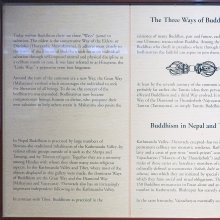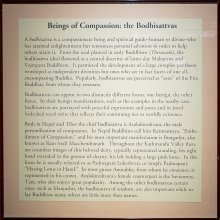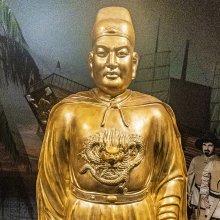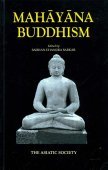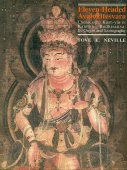Theravada, Theravāda, Thera-vada: 10 definitions
Introduction:
Theravada means something in Buddhism, Pali. If you want to know the exact meaning, history, etymology or English translation of this term then check out the descriptions on this page. Add your comment or reference to a book if you want to contribute to this summary article.
Images (photo gallery)
In Buddhism
Theravada (major branch of Buddhism)
Source: Access to Insight: A Glossary of Pali and Buddhist TermsThe "Doctrine of the Elders" - the only one of the early schools of Buddhism to have survived into the present; currently the dominant form of Buddhism in Thailand, Sri Lanka, and Burma. See also Hinayana.Source: Pali Kanon: Pali Proper NamesThe name given to the Buddhist Canon as compiled by the Elders at the Rajagaha Council (Mhv.iii.40).
It was considered the most orthodox; from it seventeen other schools branched off from time to time in later ages, as a result of schisms in the Order (Mhv.v.1f).
The followers of Theravada are called Theravadins (E.g., Cv.xxxviii.37) and their succession, Theravamsa (E.g., Cv.lii.46; liv.46).
Source: Dhamma Dana: Pali English GlossaryM (Tradition (vada) of the ancients (theras)). Buddhas doctrine, as transmitted by an uninterrupted succession of realised bhikkhus.
To distinguish it from the divergent schools that were created later on, original Buddhas teaching has been named theravada. theravada is the only school whose disciples put Buddhas word into practice, the way it is outlined in the texts of tipitaka.
See also: What is the difference between "hinayana" and "mahayana"?
Source: Pali Kanon: Manual of Buddhist Terms and Doctrines'Doctrine of the Elders', is a name of the oldest form of the Buddha's teachings, handed down to us in the Pāli language.
According to tradition, its name is derived from the fact of having been fixed by 500 holy Elders of the Order, soon after the death of the Master.
Theravāda is the only one of the old schools of Buddhism that has survived among those which Mahāyānists have called 'Hinayāna'.
It is sometimes called Southern Buddhism or Pāli Buddhism.
It is found today in Sri Lanka, Burma, Thailand, Cambodia, Laos and Chittagong (East Bengal. ) - Cf. Guide, p. 60. - (App.).
Theravāda is a major branch of Buddhism having the the Pali canon (tipitaka) as their canonical literature, which includes the vinaya-pitaka (monastic rules), the sutta-pitaka (Buddhist sermons) and the abhidhamma-pitaka (philosophy and psychology).
General definition (in Buddhism)
Source: Buddhist Door: GlossaryThera, an elder; a fully ordained monk who has past ten rainy seasons. Theravada is the doctrine of the Theras, i.e. the teaching of Southern Buddhism. It is one of the traditional 18 sects of Hinayana Buddhism. This form of Buddhism emerged out of Mahindas mission to Sri Lanka (Ceylon) during Ashokas region. They are apparently very closely related to the orthodox Vibhajyavada doctrine of Ashokas time and represent the sole remaining Hinayanist sect today. It is the form of Buddhism prevalent in S.E. Asian countries, e.g. Thailand, Sri Lanka, etc. (see Mahayana).Source: WikiPedia: BuddhismTheravada, literally, "the Teaching of the Elders" or "the Ancient Teaching", is the oldest surviving Buddhist school. It was founded in India. It is relatively conservative, and generally closest to early Buddhism, and for many centuries has been the predominant religion of Sri Lanka (about 70% of the population) and most of continental Southeast Asia (Cambodia, Laos, Burma, Thailand). It is also practiced by minorities in parts of southwest China (by the Shan and Tai ethnic groups), Vietnam (by the Khmer Krom), Bangladesh (by the ethnic groups of Baruas, Chakma, and Magh), Malaysia and Indonesia, whilst recently gaining popularity in Singapore and the Western World. Today Theravada Buddhists number over 100 million worldwide, and in recent decades Theravada has begun to take root in the West and in the Buddhist revival in India.
(cf Sanskrit: sthaviravada);
Source: Shambala Publications: GeneralTheravāda Pali, lit., “teaching of the elders of the order”; Hīnayāna school (also called the Pali school) belonging to the Sthavira group, which developed from the Vibhajyavādin school. It was founded by Moggaliputta Tissa and brought to Ceylon in 250 BCE by Mahinda, where it was propagated by the monks of the Mahāvihāra monastery. Conflicts over disciplinary questions led to schisms within the Theravāda. Today the Theravāda is widespread in the countries of Southeast Asia (Sri Lanka, Burma, Thailand, Kampuchea, Laos, etc.).
Source: academia.edu: The Chronological History of BuddhismThe Vinaya formulated in the first Buddhist council was the oldest. It was known as “Mahasanghika Vinaya”. The dispute about certain rules of Vinaya in the second Buddhist council led to a split in the Sangha. Consequently, Buddhism split into two sects, Mahasanghika and Theravada (Sthaviravada) 100 years after Buddha nirvana.
According to Theravada tradition, Mahadeva was the founder of Theravada Vinaya. Since the Theravada sect born in 1765 BC, the followers of Theravada referred to the epoch of 1765 BC as the year of Jinachakra or the beginning of Jina (Buddha) religion. Later, Theravadins mistakenly started believing that the epoch of Jinachakra of Theravada (1765 BC) and the epoch of Buddha nirvana (1865 BC) are identical.
Languages of India and abroad
Pali-English dictionary
Source: BuddhaSasana: Concise Pali-English Dictionarytheravāda : (m.) the doctrine of the Theras; the Southern Buddhism.
Source: Sutta: The Pali Text Society's Pali-English DictionaryTheravāda refers to: the doctrine of the Theras, the original Buddhist doctrine M. I, 164; Dpvs. IV, 6, 13. (Page 310)
Note: theravāda is a Pali compound consisting of the words thera and vāda.

Pali is the language of the Tipiṭaka, which is the sacred canon of Theravāda Buddhism and contains much of the Buddha’s speech. Closeley related to Sanskrit, both languages are used interchangeably between religions.
See also (Relevant definitions)
Partial matches: Thera, Vada, Vata.
Starts with: Theravada Council.
Full-text (+77): Pali, Hinayana, Elder Teachings, Buddhaghosa, Vibhajyavadin, Vibhajjavadi, Mahasamghika, Third Buddhist Council, Theriya Parampara, Mahamallaka, Aggavada, Karma, Anagamin, Tipitaka, Pakti, Buddhist Councils, Sixth Buddhist Council, Acariyavada, Vibhajjavada, Dhammayuttika Nikaya.
Relevant text
Search found 63 books and stories containing Theravada, Theravāda, Thera-vada, Thera-vāda; (plurals include: Theravadas, Theravādas, vadas, vādas). You can also click to the full overview containing English textual excerpts. Below are direct links for the most relevant articles:
A History of Indian Philosophy Volume 1 (by Surendranath Dasgupta)
Part 3 - Early Buddhist Literature < [Chapter V - Buddhist Philosophy]
Part 10 - The Schools of Theravada Buddhism < [Chapter V - Buddhist Philosophy]
Part 13 - Uncompromising Idealism or the School of Vijñānavāda Buddhism < [Chapter V - Buddhist Philosophy]
Dhyana in the Buddhist Literature (by Truong Thi Thuy La)
3.1 (a): The History of Mahāyāna Buddhism < [Chapter 3 - The Dhyāna in Mahāyāna Literature]
1.1: Introducing the Problem < [Chapter 1 - Introduction]
1.2: Survey of Researches already Conducted on the Topic < [Chapter 1 - Introduction]
Buddhist Education in Thailand (critical study) (by Smitthai Aphiwatamonkul)
1.3. Buddhism in Thai History < [Chapter 3 - The Impact of Buddhist Education on Thai Sangha]
1.2. Buddhist Monks and Monasteries < [Chapter 3 - The Impact of Buddhist Education on Thai Sangha]
Mahayana Buddhism and Early Advaita Vedanta (Study) (by Asokan N.)
Chapter 2 - Mula-madhyamika-karika Nagarjuna’s Perspective (Introduction)
Chapter 4.3 - Reality in Madhyamika (c): The Paramita Discipline
The Jhanas (by Henepola Gunaratana Mahāthera)
The Doctrinal Context of Jhāna < [Introduction]
The Way of Wisdom < [Chapter 4 - Jhānas and the Supramundane]
Socially Engaged Buddhism (with reference to Australian society) (by Phuong Thi Thu Ngo)
The Origins of Buddhism < [Chapter 3]
The Festival of Theravada Tradition < [Chapter 4]
The Festival of Mahayana Tradition < [Chapter 4]
Related products
